
MAY CONTAIN NUTS

Search Shorpy
SHORPY ART

Framed or unframed, desk size to sofa size, printed by us in Arizona and Alabama since 2007. Explore now.
Join and Share
Ad-Free Shorpy
Shorpy is funded by you. Patreon contributors get an ad-free experience.
Learn more.

Recent comments
- Robie House Roof(s)
- There is an interesting novel set here.
- I Was In Berlin
- Pronunciation
- Shell of a Shell
- Never been there but
- BUR-lin
- Hand-made smokes
- Birthplace of Tupperware, or at least its inventor
- Pulp
- Remarkably unchanged in 84 years
- The church is still there ...
- Talk about a smoke show
- Electric Hansom Cab
- I wondered the same thing.
- The location in 2009
- Pill Pusher
- Roll your own
- Rugged and real!
- Civil War history
- Early EV?
- A Charles Purcell - Mama Cass Connection
- Uncle SAAM
- Obfuscation
- One Chocolate Soldier rode away
- Victor Marquis de la Roche
- The Little House Across Way ...
- Vanderbilt Gates
- Vanderbilt Mansion
- You can still see that gate
Member Photos
The Shorpy
Printporium
Printporium
Search Shorpy
Search results -- 30 results per page
- Laurel in the Pines: 1901
- ... circa 1901. "Laurel in the Pines." This winter resort hotel on Lake Carasaljo, which opened in 1891, was leveled by fire in 1967. ... on the resort.
2. And a menu for dinner at the hotel from 1892.
"I Smell Burning" I was a kid, sleeping in a ... Posted by Dave - 07/03/2018 - 1:44pm -
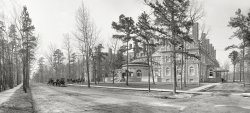
- Chair Car: 1922
- ... need to find enough room to do U-turns. Fairly easy in hotel lobbies, but hallways? Concept good, execution needs work.
[Next ... Posted by Dave - 02/21/2014 - 10:02pm -
![Chair Car: 1922 January 1922. Washington, D.C. "Man in three-wheeled vehicle." Which is, according to the nameplate, a ____G CAR. 4x5 glass negative. View full size.
BeautifulWall sconces and wall embellishments, so typical in the 20's! All would be gone by the 40's, replaced by bland industrial looking light fixtures and plain blonde walls.
Custer Chair Car?The vehicle looks a lot like the Custer Chair Car, featured on the very informative blog called Just A Car Guy, which concerns all things transportation-related.
[It could be -- both are made by a "Specialty Co." -- although our chair-car has a G in the name. - Dave]
The Segway of its eraJust need to find enough room to do U-turns. Fairly easy in hotel lobbies, but hallways? Concept good, execution needs work.
[Next stop, Walmart. - Dave]
Last standIt certainly does appear to be a Custer Car. A close-up of the rear hub on a similar photo appears to show the embossed legend "CUSTER CAR".
The inventor, Levitt Luzern Custer, filed a 1919 design patent for a very similar-looking "juvenile automobile." (It's obviously not the same design, but the resemblance is clear.)
[Two "juvenile" Custer Cars can be seen here and here on Shorpy. - Dave]
The Wheels!About 60 years ago I had an old red wagon from the early 1930s that came off a hill and got hit by a car on Long Island. I bounced six times and was OK but the wagon was a fatality. The wheels were smaller than those in this photograph but I remember the style and inside the black rubber was all "fire engine red".
StairdownI'm sure that vehicle was quite practical given the abundance of wheelchair ramps in 1922.
Tare weightI bet that thing weighs a ton (short, long or figurative.)
Restored Custer CarVideo linked from this blog.
Demon of the RoadsThe driver is none other than L. Luzern Custer himself, piloting what the caption describes as a "Cootie Car." (Washington Post, Jan. 21, 1922)
Although another clipping (The Daily Ardmoreite, 17 Nov. 1920) describes a different vehicle, a toy electric car for children similar to the ones here and here, as a Cootie Car:
(Technology, The Gallery, Cars, Trucks, Buses, D.C., Harris + Ewing)](https://www.shorpy.com/files/images/SHORPY_41899a.thumbnail.jpg)
- King Street: 1926
- ... nondescript Holiday Inn (since mercifully replaced with a Hotel Monaco).
Trolley wires Never have seen double overhead trolley ... Posted by Dave - 04/13/2011 - 12:56pm -
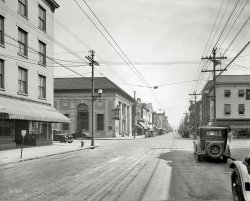
- Amarillo, Texas: 1943
- ... It appears this photo was taken from the Santa Fe Hotel on the corner of SW 9th Ave at S. Polk St. That building is still there ... Posted by Dave - 08/05/2012 - 6:34pm -
![Amarillo, Texas: 1943 View of Amarillo, Texas, taken on Santa Fe R.R. trip in March 1943. South Tyler at SW 10th Avenue. View full size. Kodachrome transparency by Jack Delano.
Amarillo StreetThat is Tyler St. and the road heading west (on the left side of the photo) is 10th located in downtown Amarillo. Do you have any more from Amarillo?
[Thanks for the info! Yes, there are more photos by Jack from Amarillo and we'll be posting them in the coming days. - Dave]
ArtBoy, if I had a time machine I'd head straight for the Amarillo Academy of Music and Art. Music! Dancing! Expression! I can only imagine the wonderful cast of characters that must have gathered there.
AmarilloI live close to Amarillo. Things have certainly changed there.
Buildings that are still there...As of the latest round of Google Maps satellite photos:
The Academy of Art & Music building, the "...r-a-way" building, and the building housing Frank's (but not the attached house in the rear) are all still there. The large gymnasium(?) building in the foreground looks to be there still, too.
The building at the left edge that goes with the Texaco sign is the same building in the foreground of this photo ("Firestone" sign showing in the other photo), and it is still standing.
In the upper right center of the photo the domed "Rudy Bauman" building as well as the one in front of it (perpendicular to the street) are both still there. Across the street from those is building housing an old-fashioned service station/mechanic (from the look of it; see the car under the canopy?) that still exists.
Most of the houses seem to have been torn down and replaced with parking lots or other buildings.
10th and TylerThe Texaco station was a large drive-through type operation, with tire sales at the back, office to the right, and fuel sales out of the Texas sun. A similar building is found on the right side of the picture along 10th street there. The smaller station building that has "Rudy Bauman" painted on it stood for years, then became a Mexican food restaurant, then was vacant for a long time. I think part of that building is still there, the domed area. There was a scandal around that restaurant when "weird" bones were discovered in its trash, and the local cat population was for some reason reduced. . . .
The blonde brick building with the curved roof is now ABC Blueprint. They have everything for surveying and blueprinting, including one of the last transit repair shops anywhere. Lots of cool stuff in there when I was younger, and still today.
The house is gone, replaced by parking. The building that says "Franks" is there, now has Mayes Investments in it. The building on the corner is now Blackstone Chinese and Thai Restaurant. Used to be good, but now its just a fast all you can eat lunch buffet.
Note the "new fangled" parking meters - an import from Oklahoma City! Those crazy Okies always find a way to finance their cities on the backs of those least able to afford it! Parking meters in downtown areas are one of the things that helped drive businesses out of downtown areas into the suburbs - why pay to park when you could park for free and go into a newer store too boot? Oh well.
The red brick streets are still in Amarillo in many places. They are now rough and could use some work, but they long outlive their asphalt replacements. Not everything modern is better!
The Music building now has a thrift store on ground level. The whole area is pretty sad nowadays.
ViewpointIt appears this photo was taken from the Santa Fe Hotel on the corner of SW 9th Ave at S. Polk St. That building is still there but is looking kinda sad based on photos from google streetview.
[A larger version of this photo with additional comments about the location is here. -tterrace]
(The Gallery, Kodachromes, Jack Delano)](https://www.shorpy.com/files/images/1a34723u.thumbnail.jpg)
- Mr. Hi-Fi of 1955
- ... The Negro Travelers' Green Book.
1111 Cleveland The hotel's ad in the 1956 Green Book puts it at "US 1 and US 23 North" in ... Posted by Dave - 03/24/2014 - 1:59pm -
![Mr. Hi-Fi of 1955 April 1955. "Duke Ellington and band members playing baseball in front of their segregated motel while touring in Florida." Who'll be first to locate the Astor? From photos by Charlotte Brooks (who died this month at age 95) for the Look magazine assignment "A Living Legend Swings On." View full size.
The Duke and The PresidentIt seems Mr. Ellington had a childhood love of the game. From Wikipedia:, "Though Ellington took piano lessons, he was more interested in baseball. "President Roosevelt (Teddy) would come by on his horse sometimes, and stop and watch us play", he recalled. Ellington went to Armstrong Technical High School in Washington, D.C. He got his first job selling peanuts at Washington Senators baseball games.
Colorful signI'm now suddenly struck with the thought that many old motel signs I've seen that seem to advertise COLOR TV excessively prominently ( though no doubt that was a nice amenity when it first appeared) may have been advertising color of a different sort a few years previously and were simply saving money on the cost of sign alterations.
Hep CatOn the left in the blazer is William "Cat" Anderson, the Ellington band's trumpet player renowned for being able to hit the high notes.
Jacksonville!This is an ad for the Astor from the 1956 The Negro Travelers' Green Book.
1111 ClevelandThe hotel's ad in the 1956 Green Book puts it at "US 1 and US 23 North" in Jacksonville. The street address appears to have been 1111 Cleveland.
1954 PontiacTo me,that looks to be a 54 Pontiac rear fender/bumper. If it is not a '54, it will be a '53.
[The answer is neither. It's a 1951 or 1952 Pontiac. - Dave]
It don't mean a thingif it ain't got that swing.
Church visible in top right corner.View Larger Map
The BusI believe this is a model PD3751 General Motors "Silversides" highway bus, or a close relative to it. These were built in the post World War II era, and more information can be found here.
(Cars, Trucks, Buses, Florida, LOOK, Music, Travel & Vacation)](https://www.shorpy.com/files/images/SHORPY_09451u.thumbnail.jpg)
- Take Five: 1922
- New York circa 1922. "Paul Specht Orchestra, Hotel Astor Roof Garden." Take five, boys, and don't burn the house down. 5x7 ... Posted by Dave - 07/10/2016 - 12:52am -
![Take Five: 1922 New York circa 1922. "Paul Specht Orchestra, Hotel Astor Roof Garden." Take five, boys, and don't burn the house down. 5x7 inch glass negative. View full size.
They sounded like thisOne of their recordings: https://youtu.be/pstM687ohOQ
It's Prohibition!We need to take the trumpet player into custody for pouring booze from his flask.
[That's a tobacco pouch. He's rolling a cigarette. - Dave]
I see the clarinetist only has one instrument with him, probably a common B-flat. Clarinets in A are often specified in orchestral works because they play better in sharp keys. The teensy saxophone is a soprano -- usually today they look like brass clarinets, but the curve here matches up with the other size saxes.
Further clarification on the clarinet -- it's got a really ancient key system on it. In fact it is a Klosé-Boehm system keying from 1839, around four generations behind the modern Oehler system that orchestra players use today, which was developed in 1900. The first black jazz players often bought old obsolete instruments shipped over from Europe so that may be where it came from. Even today some jazz players prefer playing on older key system instruments.
Where Shall We Build the StageFind some place where the floor is curved. But don't make it a symmetrical curve.
[I suspect the roof is crowned for drainage. - Dave]
Sax familyThe saxophone family is well represented here. From lowest to highest: baritone, tenor, C melody, alto (2), straight soprano, and either a curved soprano or a sopranino. I bet they kept their reed salesman busy!
All Muddled UpHere's how they sounded:
Some important players hereThere's several important early jazz musicians here: Joe Tarto is the bassist, Chauncey Morehouse is on drums and Arthur Schutt is on piano. Schutt was a true virtuoso. All prominent on record, sadly they are now known only to those interested in the jazz/dance music of the period.
The clarinet isn't particularly ancientIt's a Boehm system clarinet (minus the low E-flat key), which is still the standard today in most places. The Oehler system is supposed to be more popular with professional clarinetists in Germany and Austria. Both the Boehm and the Oehler systems superseded the Albert system, although Albert system clarinets are still popular for some kinds of music (I associate Albert clarinets with Central and Eastern Europe and with music from those areas, such as klezmer).
These ornaments... Is this still a thing? I've never seen that before. Fabulous!
Re: is this still a thing?Yeah, pretty much. Below is a chunk of a 1992 Selmer Baritone. What's NOT so much a thing anymore is the curved soprano that's sitting in front. Very unusual nowadays. Jan Garbarek still plays one far as I know. Gives a different tone from the straight version, which is way more popular. For example (gulp), Kenny G.
Sax "ornaments"......mentioned by Bolek are the engravings on a satin gold-plate Buescher True-Tone baritone sax.
A gold sax cost about double the standard finish back then (satin silver plate with gold plate inside the bell). First the bell had to be engraved, the engravings masked off and the sax body sandblasted to a satin finish. It was then silver plated, and 21k coin-gold plated over the silver. The inner areas of the engravings were smoothed bright with a burnishing tool, creating the eye catching contrasting look so well depicted in the photo.
Finally, bright gold keys with all necessary pads, springs, and corks were installed. A resident musician playtested every Buescher before it left the plant.
All this for a barisax with range only to top E flat - which would be obsolete in just a few years, when instruments with high E and F keys began to become available!
(The Gallery, G.G. Bain, Music, NYC)](https://www.shorpy.com/files/images/SHORPY-34925u.thumbnail.jpg)
- Morning Rush: 1905
- ... the Schofield Building, will open this spring as a Kimpton Hotel. In this photo, Shorpyites are enjoying the Schofield in its original ... a Marcel Breuer skyscraper thiat is now apartments and a hotel. Barely visible at the right edge of the photo is the Huntington ... Posted by Dave - 01/27/2016 - 11:10am -
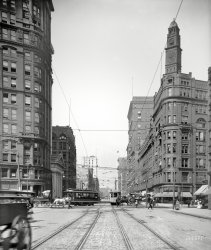
- Ahead of the Curve: 1955
- March 30, 1955. "Fontainebleau Hotel, Miami Beach. Over pool to hotel. Morris Lapidus, client." The luxe hostelry's first "season" after its ... My Dreams Oh, to make a reservation at this beautiful hotel. After checking rates for a humble Ocean Front Junior Suite with Balcony, ... Posted by Dave - 08/04/2013 - 2:18pm -
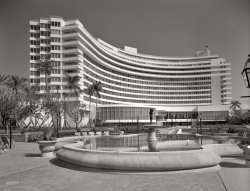
- Tire Service: 1942
- ... Tire service station." Mosher Tire, next door to the Dix Hotel. Photo by Russell Lee for the Office of War Information. View full ... Posted by Dave - 09/01/2015 - 11:04am -
![Tire Service: 1942 1942. "Hollywood, California. Tire service station." Mosher Tire, next door to the Dix Hotel. Photo by Russell Lee for the Office of War Information. View full size.
TopperSomething older is parked at the curb to the right of the frame and it appears to have a So Cal AAA license plate topper attached to it!
DeluxeNice 1938 ford Deluxe Tudor sedan parked in front of the bargain rack. I have a '38 Standard Tudor...but not that nice.
Don't bump your head3rd floor room/special rate.
Draft registrationMr. Mosher would be registering for World War I not World War II. His age was 57 in 1942.
[Age requirement for WWII draft registration was 18-64. -tterrace]
I stand corrected. Thanks tterrace as I dropped the ball you picked it up.
MotorolaMotorola was the big name - if not the only one - in auto radios at that time. The company had a large stock of auto radios at the war's beginning. Since auto manufacturing was suspended for the duration of the war, Motorola sold "chairside" radios, which were auto radios converted to 110-volt AC power and installed into end tables.
Rubber RoomsToo bad the tiny top floor room doesn't provide a view of all those luscious, war-rationed tires.
Still going in 1968... according this post in a forum discussion. It says:
"The founder of Mosher Tire Service was Lewis Dean Mosher, born in Illinois on September 26, 1885. His obituary says he was a pioneer in North Hollywood beginning in 1927 and that he had founded his tire business in Los Angeles in 1905 . . . When he filled out a draft registration for WWII he . . . lists his business address as 1534 N. Cahuenga Bl, North Hollywood."
Ah, those daysWhen a half a dozen sizes fit ALL cars. Today, it seems tire shops must have hundreds of sizes, let alone brands.
Part of my family history!This is where my grandfather, Lewis Dean Mosher worked. Later in 1942 the business moved to 12117 Burbank Blvd in North Hollywood. My father and my uncle ended up working together with my grandfather for some time. Eventually my dad, Merrill D. Mosher operated it until he retired. The original structure on Burbank Blvd is no longer there, but the house next door, where my grandparents lived starting in 1927, is still there.
Here is an earlier image, probably taken in 1937.
(The Gallery, Cars, Trucks, Buses, Los Angeles, Russell Lee)](https://www.shorpy.com/files/images/SHORPY-8d28160a.thumbnail.jpg)
- New Kenmore: 1906
- Albany, New York, circa 1906. "New Kenmore Hotel." Familiar street fixtures of the era include the carbon arc lamp, ... Posted by Dave - 08/15/2012 - 3:52pm -
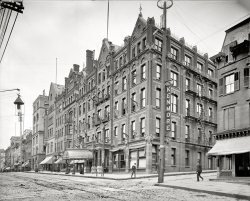
- Tremont Temple: 1900
- ...
The leftmost bit of building here is the Parker House Hotel, a place with amazing history (Ho Chi Minh worked there as a baker ... There's another good view of this section of street in the hotel's Wikipedia article.
The rightmost strip of building in the photo is ... Posted by Dave - 07/30/2012 - 4:36pm -
![Tremont Temple: 1900 Circa 1900. "Tremont Temple, Boston." The Baptist church and auditorium. 8x10 inch dry plate glass negative, Detroit Publishing Company. View full size.
Packed sidewalksThose sidewalks are wall to wall people. I wonder if Sunday services at the Temple had just ended when the photo wast taken. I'm also curious whether the two buildings to the left of the church were hotels or upscale apartment buildings.
And I found myself musing about the variety of horsedrawn vehicles on the street. So much to see & ponder.
Say, where is everyone going?Must be a sale or perhaps free beer. Almost everyone in the photo is headed in the same direction.
Still standing.Tremont Temple still stands in 2011 though all of those wonderful buildings to either side are long gone. Circa 1900 is correct. The lack of trolley tracks in Tremont St., removed shortly after the opening of the subway under this segment of Tremont in 1898, date the picture.
Horseless CarriageLooks like a horseless carriage lower right with what appears to have pneumatic tires. Early for 1900.
[That's an electric brougham or delivery wagon with solid rubber tires, of the type recently discussed here. - Dave]
More Is MoreThe mixture of styles boggles the mind.
If built a bit later, it might have incorporated a bit of Bauhaus influence, or Mies Van Der Rohe in one little corner.
LandmarksI walk past this fantastic building every day on my way to work. It's in remarkably good condition considering its age and location. I find it very strange that such a grand and tall facade is on a rather narrow section of street; the strange angle of this photo is possibly because a straight-on shot wouldn't be able to show the facade well at all!
The leftmost bit of building here is the Parker House Hotel, a place with amazing history (Ho Chi Minh worked there as a baker 1911-1913 and Malcolm X worked as a busboy in the 1940s). The next-to-leftmost building was bought and both were replaced in the 1920s with a new integrated Parker House building. There's another good view of this section of street in the hotel's Wikipedia article.
The rightmost strip of building in the photo is the corner of an office building at 73 Tremont, still standing and currently in use by Suffolk University.
All the buildings visible to the right of the Tremont Temple are no longer standing.
(The Gallery, Boston, DPC, Horses)](https://www.shorpy.com/files/images/SHORPY_4a07555a.thumbnail.jpg)
- Ducktown Scab Committee: 1939
- ... usually gathered on street corners, either in front of the hotel or the company store, just to talk and pass the time.
The first ... on this; he lives two doors down from the old Ducktown Hotel on Main Street where this picture was taken.
Delia
Ducktown ... Posted by Dave - 05/24/2008 - 1:31pm -
![Ducktown Scab Committee: 1939 October 1939. "Picketing. Copper miners on strike waiting for scabs to come out of the mines. Ducktown, Tennessee." View full size. 35mm nitrate negative by Marion Post Wolcott for the Farm Security Administration.
Scab CommitteeSo Mr. Right has his cudgel and Middle Boy is holding a rock or brick. Can't wait to see what happens!
Rock Or Harmonica?To me the rock looks like a harmonica and the cudgel could be a walking stick because of a mine accident but then I am a 100% Union man and my view may be clouded.
[Rock. - Dave]
Scab CommitteeMy grandfather, John McGee, worked as a supervisor and demolitions expert in the Burra Burra mines in Ducktown, and I was just visiting family there. Folk in town say that this wasn't a scab committee, and these men weren't holding weapons.
Instead, they were sitting around Main Street, whittling (note the carved end of the stick). This was a very common practice in those days; the men usually gathered on street corners, either in front of the hotel or the company store, just to talk and pass the time.
The first gentleman is Wesley Davis, the young man in the middle is Everette Goode and the third man is Tom Mealer. I saw Everette Goode during my visit (and yes, he was wearing overalls).
A version of this photo is featured in this year's Copper Basin Pictorial Calendar from the Ducktown Basin museum; these gentlemen are the September feature.
BTW, my grandfather was a part of that strike; in fact, he was put in jail by the mining company on suspicion of blowing up the power lines to the mines. But they couldn't prove anything, so he was released.
I want to thank David Beckler for his help on this; he lives two doors down from the old Ducktown Hotel on Main Street where this picture was taken.
Delia
Ducktown MinersHi Delia,
I visited the mine museum yesterday (Nov. 8) and looked at that same calendar page, but it indicated that the man on the left was Bert Hensley. Here's a current photo of the corner where they were sitting:
(The Gallery, M.P. Wolcott, Mining)](https://www.shorpy.com/files/images/8a40873u.thumbnail.jpg)
- The Garden: 1904
- Circa 1904. "Garden Hotel, Atlantic City." Sharing the corner with a high-tech arc lamp. 8x10 inch ... at Illinois and Pacific began life in 1897 as The Garden Hotel. The hotel was demolished in 1933 and a post office was erected on the site four ... Posted by Dave - 08/21/2012 - 5:18pm -
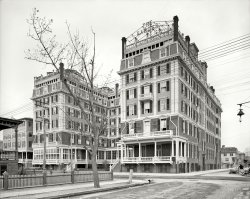
- Adirondack Porch: 1906
- ... it burned in 1912. Apparently the best way to reach the hotel was by steamer, across Lake George. With no nearby fire-fighting equipment, the hotel went up in smoke, even with a bucket-brigade bringing water from the ... Posted by Dave - 09/06/2013 - 10:32am -

- Circle in the Square: 1908
- ... after his term as President. It was converted to a hotel by his son and later renamed the Castle Inn for the 1901 Pan-American Exposition. Demolished in 1919 to make way for another hotel. More information available at History of Buffalo .
Shipshape ... Posted by Dave - 07/22/2012 - 10:40am -
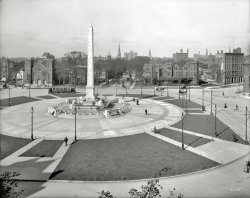
- The Billiard Room: 1908
- ... New York, circa 1908. "Billiard room, Fort William Henry Hotel." 8x10 inch dry plate glass negative, Detroit Publishing Company. View ... lovely tables. But this seems to be an afterthought by the hotel. The intrusive column on the right of the pool table would prevent any ... Posted by Dave - 08/08/2012 - 7:11pm -

- Plaza Garage: 1939
- November 1939. "Hotel and garage in Gonzales, Texas." Medium format negative by Russell Lee for ... View full size.
Little Remains The hotel is gone, though the sides are still there. The Plaza Garage survives with ... plaza Hmm, let me guess: The Plaza Garage and the Plaza Hotel face the town's plaza, right? Do I get a prize?
Somebody is going to ... Posted by Dave - 09/21/2018 - 12:08pm -
![Plaza Garage: 1939 November 1939. "Hotel and garage in Gonzales, Texas." Medium format negative by Russell Lee for the Farm Security Administration. View full size.
Little RemainsThe hotel is gone, though the sides are still there. The Plaza Garage survives with some remodeling.
On the plazaHmm, let me guess: The Plaza Garage and the Plaza Hotel face the town's plaza, right? Do I get a prize?
Somebody is going to name those cars. The one with the truck bed is awful cute! Note the three digit phone number. How many telephones in Gonzales in 1939?
So what happened to the Plaza?Aww, c'mon. What always happens to Shorpy hotels.
It burned down. In January 1966.
http://www.gonzalesinquirer.com/stories/this-month-in-gonzales-county-hi...
Correct me if I'm wrongThere's a sign on the wall of the building to the left of the gas pump. It looks like it says "Credit Cards." Credit cards in a town the size of Gonzales, Texas ... in 1939?
[Gas station credit cards were nothing unusual in 1939. - Dave]
(The Gallery, Cars, Trucks, Buses, Gas Stations, Russell Lee, Small Towns)](https://www.shorpy.com/files/images/SHORPY-8b23187a.thumbnail.jpg)
- Chattanooga Depot: 1864
- ... town where one can today find the Chattanooga ChooChoo, a hotel.
Not what Glenn Miller had in mind Not the luxurious Chattanooga ... Posted by Dave - 10/16/2008 - 8:04am -
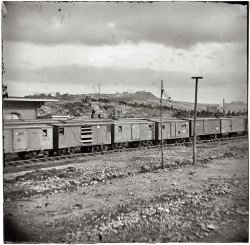
- Fashionista: 1912
- ... these photos were taken?
Going to the website for the hotel will produce an abundance of photos with the rocking chairs and benches I ... Posted by 3dfoto - 10/24/2016 - 3:50pm -
![Fashionista: 1912 From the collection of film and 4x5 glass negatives I recently purchased that seem to have been taken in upstate New York about 1912. This is from a film negative that has been bent, hence the flare on the right side. The lady's dress is spectacular, and she is coordinated with gloves and white shoes. I don't think this was an inexpensive outfit. View full size.
Sunday Best Maybe?Could this be a Sunday best outfit? Maybe visiting the in-laws? Either way, beautiful. The camera definitely loves this lady, bend or no bend in the negative.
FabricMy guess would be that the dress is linen, which was a common fabric for "day dresses" like this one. Linen is pretty comfortable/breathable in hot weather, even in a fairly heavy weave. It's also very prone to wrinkling, so this lady's perfectly pressed dress may also be well-starched.
Smile, dammit, smileI know nobody cares what I think and I know many people who would never allow themselves to crack a smile in their posed pictures because it may not be "cool" or sophisticated, but this elegant lady would look a million times better, younger and healthier if only she would have smiled or at least put on a pleasant face. Instead she has a dour expression in both of the photos we've seen that makes her look gloomy and judgmental, with a superior attitude. Even Mona Lisa looks more approachable. Perhaps we will see a happy picture of her in the future. (That's my story and I'm stickin' to it).
[Try this one. -tterrace]
Colors?Seeing this vision of sartorial splendor, I wonder what she looked like in color. Gloves are obviously white; dress is off white, probably a light cream color. The cuffs and collar make the dress. I'm thinking gold braid over a deep midnight blue. Stunning indeed.
Was this same lady...... in the rocking chair a few photos earlier?
[Yes. - tterrace]
Lady in RedNatural beauty. Does not appear to be wearing any makeup or lipstick. For color, I'm guessing dark red or maroon cuffs with gold braid. Hat is red, dress is off white.
A Lady, IndeedCarriage, bearing, clothing...everything about her says she's had the best all her life, including education. And in 8 more years she'll be able to vote. How much talent in America was wasted while living in men's shadows?
Yes, but what is the fabricWhat is the fabric the dress is made from? Very thick and stiff but pliable - and warm?
A ladywith style and determination, judging by the look on her face.
Saranac Lake?The background looks a bit too bucolic for Saratoga. And the bench looks a bit rough-hewn for Chautauqua. Saranac Lake was a summer destination for wealthy New Yorkers; possibly this series was taken there.
Mohonk Mountain House?When I saw the first photo of the lady sitting in the rocking chair, it sparked a thought in my mind but I let it pass for the moment.
Now seeing the second photo of the lady sitting on a rough-hewn bench, I am even more suspicious.
There is a resort in New Paltz, NY called the Mohionk Mountain House. Like me, anyone who has ever visited there is familiar with all the rocking chairs on the porches, and the rough-hewn benches and gazebos along the walking paths.
I wonder if this is where these photos were taken?
Going to the website for the hotel will produce an abundance of photos with the rocking chairs and benches I have alluded to....
Dress commentsMy wife and I have done historical costuming for years. The fabric of this dress is almost certainly worsted wool. It's surface smoothness looks like worsted and the folds and drapes are too full to be even heavy linen. The dress she's wearing in the first photo posted (the eyelet lace dress) is either linen or cotton or possibly even a blend of the two.
As to colors, that's harder to determine than you might think. Early black and white films didn't respond to colors in quite the way we expect nowadays. Silver halide is most responsive to the blue end of the spectrum. Colors from the other end often wound up overly dark. With glass plate negatives, special dies and filters could be used to produce a more accurate tonal map of the colors, but those didn't work with film at this time.
It wouldn't surprise me if the dress was actually bright blue with bright yellow collar and cuffs or something like that. Wool takes die especially well and so was often very brightly colored (particularly after the invention of aniline dyes in the 1850s).
(ShorpyBlog, Member Gallery)](https://www.shorpy.com/files/images/img505_1024.thumbnail.jpg)
- Yerkes Mansion: 1908
- ... he was residing in an apartment at the Waldorf Astoria Hotel, and not in the mansion seen here, which was occupied by his wife, as ... Posted by Dave - 06/06/2011 - 3:25am -
![Yerkes Mansion: 1908 New York circa 1908. "Charles T. Yerkes house, Fifth Avenue and East 68th." 8x10 glass negative, George Grantham Bain Collection. View full size.
Creator of the Chicago Loop Charles Tyson Yerkes, as the robber-baron-in-chief of Chicago traction, acquired a distinctly unsavory reputation in the Windy City and was eventually run out of town. But he created - by hook AND by by crook - one of Chicago's greatest assets: the elevated railroad loop that encircles the downtown business district, which was completed in 1897. The name "Loop" derives from the turn-around circuits of the cable car lines built in Chicago in the 1880s, but it is forever linked to the giant elevated train merry-go-round that remains a favorite with residents, tourists, and filmmakers alike.
"City Loses Yerkes Library"Financier and public transportation developer Charles T. Yerkes was one of those 19th Century capitalists whose ruthless business practices defined the term "robber baron." When he died of kidney disease in 1905, he was residing in an apartment at the Waldorf Astoria Hotel, and not in the mansion seen here, which was occupied by his wife, as reported in his New York Times obituary on December 30, 1905.
The Yerkes mansion was in the news again in 1908, when the Times reported that its attached library and art gallery, willed by Yerkes to the city for public use, was instead being lost to foreclosure.
Couldn't be more... spooky!
East 68thSomewhere along the street is an apartment building owned by a couple named Mertz.
On The AvenueIn 1895 the Yerkes Mansion was replaced by Thomas Fortune Ryan, another robber baron, who built an even larger house and garden on 2 lots. That lasted until 1950 when the architecturally ordinary 860 Fifth Avenue was built for the rich and famous.
Gone and ForgottenWhen I first saw this picture I thought "Who in the world was Charles T. Yerkes and what is he famous for?"
Well, after reading the remarks, I have decided that it is to mankind's benefit that the man has been, more or less, forgotten in just over 100 years. Too bad he didn't use some of his ill gotten gains to help people. Maybe his name would be remembered in the same spirit as Andrew Carnegie.
[He did get those rail lines built, and provided employment for thousands. As for the pejorative term "robber baron," the people who most objected to those sharp elbows were other industrialists. - Dave]
Yerkes ObservatoryI'm familiar with Yerkes in association with the observatory by that name. The U. of Chicago astronomer George Ellery Hale persuaded him to fund the observatory by pointing out that his name would be on the largest telescope in the world. Those tycoons love having their egos stroked, eh.
Dreiser booksTheodore Dreiser wrote three books "suggested" by Yerkes' life ("The Financier," "The Titan" and "The Stoic"), and they are a great read for anyone interested in that time period.
(The Gallery, G.G. Bain, NYC)](https://www.shorpy.com/files/images/01397u.thumbnail.jpg)
- Telco Group: 1928
- ... 1928. "Cheasapeake & Potomac Telephone Co., Willard Hotel." National Photo Company Collection glass negative. View full size. ... Posted by Dave - 09/12/2011 - 5:05pm -
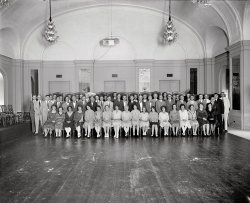
- Catch O' the Day: 1905
- Circa 1905. "Lower St. Regis Lake, Paul Smith's Hotel, Adirondack Mountains, N.Y." 8x10 inch glass negative, Detroit Publishing ... According to Wikipedia, "Smith died in 1912, but the hotel continued under his son, Phelps, until it burned down in 1930 ."
... Posted by Dave - 03/15/2017 - 8:32am -
![Catch O' the Day: 1905 Circa 1905. "Lower St. Regis Lake, Paul Smith's Hotel, Adirondack Mountains, N.Y." 8x10 inch glass negative, Detroit Publishing Company. View full size.
One of the firstOne of the first Inns in the Adirondack mountains. Three presidents (Cleveland, Roosevelt, Coolidge) stayed there as well as PT Barnum and many other celebrities.
As with many of these fine old buildings, it succumbed to fire in 1930.
RifleIs that a '92 Winchester?
The Buck Stops HereOdd place to pose with that THAT trophy.
[Unless the canoe provided the transport to and from the hunt. -tterrace]
Good point!
Oh Deer CollegeNow Paul Smith's College, very much in tune with the nature of Adirondack Park.
A sport that never really caught onDeer Fishing.
You knew what was going to happenAccording to Wikipedia, "Smith died in 1912, but the hotel continued under his son, Phelps, until it burned down in 1930."
Prize rifleIt would appear to be a Model 94 Winchester. The action appears to be longer than a Model 92. Who knows, the hunter may have been using one of those newly minted .30 WCF's, AKA a .30-30.
(The Gallery, Animals, Boats & Bridges, DPC)](https://www.shorpy.com/files/images/SHORPY-4a17125a.thumbnail.jpg)
- DOJ: 1915
- ... which point the building was adapted to serve use as the Hotel Baltic.
In 1899, with the old Department of Justice Building falling ... up what was supposed to be a short term residence in the Hotel Baltic: the original lease was for 18 months. Months turned into years ... Posted by Dave - 08/22/2012 - 8:37pm -
![DOJ: 1915 Washington, D.C., circa 1915. The Department of Justice building at 1435 K Street N.W. Harris & Ewing Collection glass negative. View full size.
Dude Descending a StaircaseTwo ghosts, or one?
CrampedHow did they fit all that bureaucracy into such a tiny building? Maybe the ghost was J Edgar Hoover spying on his future bosses several years before he started working there.
Bureaucracy constrainedThis was back in the time when people really did believe in a small central government. Even into the 1940s: Truman wrapped up WWII with a White House staff of 11 people.
Sen. T.W. Palmer ResidenceThis attractive building saw many uses over its short 41 year lifetime. Sorting through all the history has proved to be one of the more substantial projects I have done here at Shorpy.
It was originally erected in 1884 as the residence of Senator Thomas W. Palmer of Michigan. The initial building, the left half of what is seen here, was designed by J.R. Thomas (probably John R. Thomas) of New York. The right half of the building was added ten years later under the direction of its then owner, William E. Schneider. After this expansion it became the new home of the Norwood Institute: an elite preparatory school for girls. The Norwood Institute appears to have graduated its final class in 1897, at which point the building was adapted to serve use as the Hotel Baltic.
In 1899, with the old Department of Justice Building falling down, Congress authorized money for construction of a new building and the department took up what was supposed to be a short term residence in the Hotel Baltic: the original lease was for 18 months. Months turned into years as congress squabbled about costs, siting, etc. Finally in 1916, the Department of Justice was able to move into its new building at the nearby corner of 15th and Vermont.
In 1920, the building was purchased by George Washington University to house their Law School. After 5 years, the law school moved to its new home in Stockton Hall. After this, things turn to the worse. The building was razed in January 1926 to make way for the construction of a "modern office building" to house the real estate firm of Shannon & Luchs, Inc.
The following 1894 article refers to this architectural style as "modern gothic." By today's definitions, I think it falls more under the umbrella of Richardsonian Romanesque
Senator Palmer's House
Col. Robert I. Fleming has just received from Mr. J.R. Thomas, a prominent New York architect, the drawings for a residence which he will soon erect for Senator T.W. Palmer, on K street, fronting on McPherson square, and adjoining the fine residences of Col. Payson on the west and Mr. Lowry on the east. The drawings show one of the finest single houses about Washington and denote at once the practicable and artistic ideas of the architect. The building will have a frontage of 32 feet, with an entire depth of 123 feet 6 inches, and will be five stories in height. The facade, of modern Gothic design, is constructed entirely of Potomac red sandstone, and will present an effect as handsome as it is novel in this city. This design is extensively used in New York, but will be accepted here as an agreeable change.
The principal entrance is reached by a flight of stone steps, ornamented with heavy newels and balustrades, and above the massive doors a semi-circular door-piece of rich design is crowned by a beautiful buttress in the form of a sea shell, which supports a heavy stone balcony. There are two large semi-circular windows opening from the parlor on separate balconies similar in design to the one overhanging the main entrance, while from the second story springs an artistic oriel, resting on handsome carved stone and finished with rich cornices and balustrade. Above this, accessible from the third story, is an elegant loggia, or gallery with in the house, but open to the street, a feature seldom seen here, but extensively used by the Italians. The fourth floor is ornamented by a group of six arched windows, and the whole is surmounted by cornices of handsome though simple design. [ article goes on to describe interior]
Washington Post, Jun 30, 1884
Note, in the following account of the addition, the entrance was moved. I think the original entrance was the third window from left on the ground floor. Also curious to me, is the change in building stone from Potomac red sandstone to Hummelstown brownstone. It is somewhat difficult to tell in black & white, but the materials appear to match well. I'm hardly a qualified field geologist so am not familiar with the comparative appearance of Appalachian sandstones. Of note, though, is that Hummelstown brownstone is characterized by reddish to purplish hues.
Big Building Projects
Another project of interest is announced to the effect that the vacant lot adjoining the late residence of Senator Palmer, 1435 K street, is to be improved by a handsome residence building, which will be in design and detail a duplicate of and connected with the existing house. William E. Schneider, the owner, is having plans prepared for a five-story structure, 25x120 feet, with the entire front of Hummelstown brownstone and porch of same material. The entrance will be by way of a large recessed arch, and on the upper story the windows will have balustraded balconies. At the second story there will be an ornamental oriel bay window. The top floor will finish with a row of colonnaded windows. ... The new building and the residence of Senator Palmer will be occupied when completed as a boarding-school for the Norwood Institute, of which Mrs. William D. Cabell is principal. No approximate estimate has as yet been made of the cost of the building. The Palmer house originally cost $110,000, and is finished in very expensive style.
Washington Post, Sep 7, 1894
Potomac red, Hummelstown brownDuring the last part of the 19th century, Allen Walton, owner of Hummelstown Brownstone, was promoting his product in the D.C. area. It came in various hues that probably matched existing stone quite well. The Christian Heurich mansion is an example of Hummelstown brownstone with a pink to purple hue.
Architectural confusionI'm confused by the descriptions of this building. The second paragraph under "Senator Palmer's House" describes the right half of the building almost exactly. But "Big Building Projects" doesn't match what I'm seeing on the left. I don't think the front door was moved; to me it seems like William Schneider's big plans were simplified before the structure was built. It appears the entire facade was covered with stone so the two halves blend seamlessly. At any rate, this is a fascinating building and it's a shame it was demolished.
[It looks like the original house is the right side of the main building, with the entrance, and the addition is the part to the left of the entry. Some of the features described in "Big Building Projects" (the entrance, the oriel bay) were already there, in the older right half. - Dave]
Re: Architectural confusionYes, I think I was confused in my original post here regarding which portion of the building is the older part. I think Dave's right that the right hand side is the original building.
"My original plan was to build a forty-thousand dollar house here," said Senator Palmer to a Post reporter last evening, "but the figures have increased beyond ninety thousand, and the end is not yet in sight. still I do not regret my action, for real estate is not destined to retrograde in Washington and a more charming spot for a residence cannot be imagined."
Washington Post, Jan 4, 1886
(The Gallery, D.C., Harris + Ewing)](https://www.shorpy.com/files/images/05331a.thumbnail.jpg)
- The Singing Valise: 1922
- ... of Engineers meeting here last month at the Drake Hotel, by F.W. Dunmore of the radio laboratory of the U.S. Bureau of Standards. ... confines of the steel, concrete and brick structure of the hotel, amazed even those of the engineers who thought they had seen the very ... Posted by Dave - 07/18/2020 - 4:14pm -
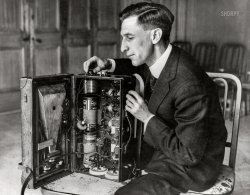
- The Jungle Trail: 1910
- ... St. Patrick's Day Ball.
They were likely guests at the Hotel Royal Poinciana coming back from or heading to Alligator Joe's- a ... Posted by Dave - 07/29/2012 - 10:13am -
![The Jungle Trail: 1910 Continuing our Sunshine State sojourn circa 1910. "The jungle trail, Palm Beach, Florida." 8x10 inch glass negative, Detroit Publishing Company. View full size.
Old-school E-ticket ride"And now, the most dangerous part of our journey- the return to civilization and those Florida railways."
A star in the jungleHe really looks like Paul Newman.
Steam bathCan you say "overdressed"?
[Florida was a winter resort, so maybe not. - Dave]
The Palm Beach AfromobileAlthough a decidedly un-PC term by today's standards, these Palm Beach wicker chariots, almost always powered by African-Americans, were widely called "Afromobiles" as a humorous twist on the newfangled term "automobile."
These folks are riding under the limbs of a local oddity known as the Florida strangler fig tree (Ficus aurea), which begins life in another tree until it strangles it. The fig then thrives on the nutrients left by the decaying host.... Hmmm, sounds like a good Halloween story!
Keebler treeNow I know where the elves bake all those delicious treats.
Tis the SeasonMost guests arrive in Palm around New Year's Day. The season ended and the resorts closed shortly after the big St. Patrick's Day Ball.
They were likely guests at the Hotel Royal Poinciana coming back from or heading to Alligator Joe's- a popular destination at the end of the Jungle Trail.
https://www.shorpy.com/node/7748
Looking CloselyDo I see Toto way back on the path?
(The Gallery, DPC, Florida, Travel & Vacation)](https://www.shorpy.com/files/images/4a24126a.thumbnail.jpg)
- Lexington Market: 1903
- ... out the trio of sawhorse wire poles on top of the Acme Hotel and Restaurant in the Duluth 1900 photo. ... Posted by Dave - 07/23/2012 - 6:46pm -
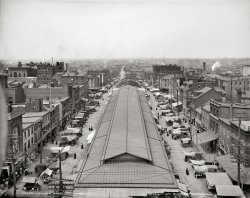
- Garfield Building: 1905
- ... the Hollenden is long gone, but don't know. It was a nice hotel then.
Exposure time Looking at the shadow of this walking person ... Posted by Dave - 01/27/2022 - 12:02am -
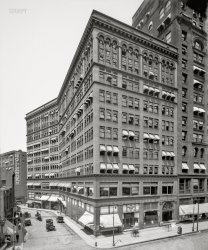
- Welcome, Wagon: 1919
- ... I. Neal (1871 - 1965). Having been the proprietor of the Hotel Arthur (1911-1912) and the Hotel Yale (1913 - 1919) in San Diego, he knew what accommodations were needed ... Posted by Dave - 08/05/2016 - 9:57pm -
![Welcome, Wagon: 1919 San Francisco circa 1919. "Bus" is all it says on the sleeve of this 5x7 glass negative showing a motor home on an Atterbury truck chassis. In the Firestone display window, it's beginning to look a little like New Year's. View full size.
Mystery hardwareI can usually identify most components of early automobiles, but those vertical cylinders which appear to be attached to the forward end of the front springs have me baffled.
Some sort of primordial air suspension or shock absorber??
Shock absorbers, probably by Gruss, as seen and commented on in this photo. -tterrace]
Cross-CountryAtterbury trucks were made in Buffalo, New York.
Automobile Row againEarle C. Anthony's REO and Dort dealership was at 1400 Van Ness Ave., with Firestone Tire & Rubber (F.C. Flickinger, manager) next door at 1414.
San Francisco Planning Commission on 1400 Van Ness: "This is a fine restrained Classical Revival auto showroom with a rusticated base and Corinthian pilasters. The bay and pilaster width relate to the width of the street, with the Van Ness facade having a larger scale than the Bush facade. Because of the building’s corner location it would be difficult to alter or add to without significantly harming its integrity; therefore the building should remain intact."
The PalaceAlmost certainly, the gentleman standing just to the right of the driver's door is Arthur M. Neal (1869 - 1938) who built this traveling home for himself and his wife Fannie I. Neal (1871 - 1965). Having been the proprietor of the Hotel Arthur (1911-1912) and the Hotel Yale (1913 - 1919) in San Diego, he knew what accommodations were needed when traveling away from home. They nicknamed their vehicle "The Palace." The San Diego commercial automobile body firm of Klersy & Caldwell provided assistance with the build of the motorhome which was painted brown. Based on California vehicle registrations, the Atterbury was used by the New Southern Hotel as a bus prior to the Neal's ownership. It is likely a Model D built circa 1914.
Newspaper articles start appearing with photos of their mobile home in October, 1919, but the couple stated in the Roseburg [Oregon] Review, on October 3rd, that they had been on the road for eight months already. All of the earliest newspaper photos of their caravan do not show the Gruss shock absorbers installed, leading me to wonder if perhaps the Firestone dealer installed the devices for the Neal's. After visiting San Francisco their intent was to head east for a year.
The article below, from the magazine "Sunset," published in June 1920, describes more about their vehicle and the Neal's extended travels. This article is the last published piece I found about their excursion. The pair returned to San Diego later in 1920 or early 1921 where they became the managers of an apartment building at 1313 24th Street until Arthur Neal passed away in 1938. Fannie Neal continued residing there until just after WWII, but, even after leaving this apartment, she remained in San Diego for the rest of her life. She died at the age of 93 in 1965.
(The Gallery, Cars, Trucks, Buses, Chris Helin, San Francisco)](https://www.shorpy.com/files/images/SHORPY-1013.thumbnail.jpg)
- Glass Princess: 1916
- ... lost a maternal aunt (she was 26 when she was trapped in a hotel fire), which caused a profound sadness that still lingers. Glad you have ... Posted by tterrace - 05/09/2022 - 10:00am -
![Glass Princess: 1916 My mother's older sister Mary in a glass plate negative taken about 1916 in the family home in San Francisco. She's also been seen on Shorpy here in the same room and with her Model T Roadster here. Mary's was a short life; she died from tuberculosis in 1922. View full size.
That's so sad.The duke was in the parlour playing piano for the children's holiday.
Layers and laddersMary's face, with its pensive expression, reminds me of the only known photograph of my favorite poet: Emily Dickinson, the Belle of Amherst. The filmy white (I think) dress is fitting too. But Mary's laddered hosiery and frayed shoes make me sad. I like the lighthearted picture of her standing beside her car much better. I'm sorry she died young.
Conjecture on the yearBased on the pillow beside her, I believe that this picture was taken in 1917-1918, probably the latter. The pillow has an American flag and a single star, perhaps alluding to the possibility that someone was in the U.S. Armed Forces during a time of war, maybe her husband or brother.
[An interesting theory but the pillow, which features both the U.S. and California state flags, commemorates Native Daughters of the Golden West, an organization for women born in California. - Dave]
Forever young ...Sad that Mary's life was so short.
NSGWNative Sons of the Golden West is, I believe, the "GW" on the pillow.
[You're getting warm -- it's a Native Daughters of the Golden West pillow. - Dave]
(Not bad for first try I guess. But will partial credit get me into the qualifying round ? - Not )
Mary RememberedLove these family photos. My favorite of Mary is in the parlor with her family. The far-away, whimsical look in her eyes is how I would choose to remember her. I also lost a maternal aunt (she was 26 when she was trapped in a hotel fire), which caused a profound sadness that still lingers. Glad you have these permanent memories of her life to share with us and hold close to your hearts. Thanks for sharing.
(ShorpyBlog, Member Gallery, tterrapix)](https://www.shorpy.com/files/images/2336_SHORPY.thumbnail.jpg)
- Astor House: 1908
- ... circa 1908. "Astor House, Vesey Street and Broadway." The hotel, built by the financier John Jacob Astor in 1836, was home to ... Posted by Dave - 08/01/2012 - 4:26pm -
![Astor House: 1908 New York circa 1908. "Astor House, Vesey Street and Broadway." The hotel, built by the financier John Jacob Astor in 1836, was home to presidents and potentates over its long history. 8x10 inch glass negative. View full size.
No Ladies?Astonishing, how sexually segregated American life was back then: there may be one woman at the far end of the block (white hat).
It's a Man's WorldWhere did they hide all the women that day? I'm not finding any unless they're inside the streetcar. Also I was thinking that I must have lived my life without ever having owned a "cravenette" so I looked it up and it is a process of waterproofing fabrics, whatever they may be, hats, coats, suits, etc. and that particular store does seem to specialize in umbrellas, outerwear, things like that. So now ya know. You're welcome.
"Cravenettes"Cravenette is a waterproofing process for clothes (new one on me). So were they offering waterproof clothes or offering TO waterproof your clothes? (if the latter, I wonder how that was done). Either way, great word, as is the visual of the glasses with the big eyes in them.
["Cravenettes" would be outerwear (mainly raincoats) made of cravenette, a rubberless waterproof fabric. - Dave]
Trolley Car QuestionsWere trolleys like the one pictured powered by electricity? If so was the electrical power provided via the rails? Could these vehicles be operated on a rainy day?
[The electric power supply is underground, accessed through the slot between the rails. - Dave]
Early views of the Astor HouseSome of these architectural photos inspire me to look for earlier views that might show the buildings as they were first seen. The New York Public Library's online digital archive includes many 19th Century prints and photos of the Astor house. One of these, an 1848 engraving by J. B. Forrest and F. B. Nichols, depicts the Astor House and its august neighbor, the 18th Century St. Paul's Church. Some of the church's old gravestones can be seen in the photo above. The other print, included here for its wonderment, is a hand colored Currier & Ives print depicting the circus band wagon of Van Amburgh's Menagerie as it passed the Astor House on April 20th, 1846. Huzzah!
Watchful EyesThank you for choosing the Astor House; the warmest building in New York. You'll be happy to note from the chimneys atop our building, every one of the rooms in your suite is furnished with two or three fireplaces for your comfort.
Fireplaces aside, I don't recall too many buildings from this era so gratuitously fire-escaped either. I wonder what year they started being required? Curious what Marsh's (Truss?) Office might be too. It must have been successful, having been established in 1820.
The other thing that draws my attention in this photo are the huge eyes above J. Ehrlich & Sons. They look like the eyes of someone who's on the brink of sanity, or has been awake for about 72 hours. Pretty modern advertising concept for 1908 though.. They wouldn't be too out of place today.
(The Gallery, DPC, NYC, Stores & Markets, Streetcars)](https://www.shorpy.com/files/images/4a22988a.thumbnail.jpg)























